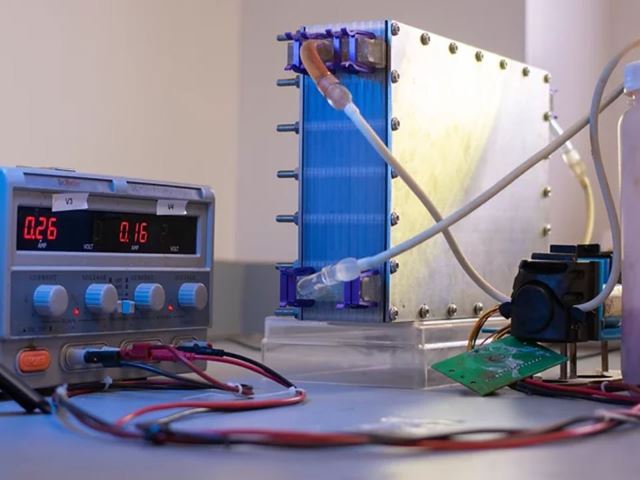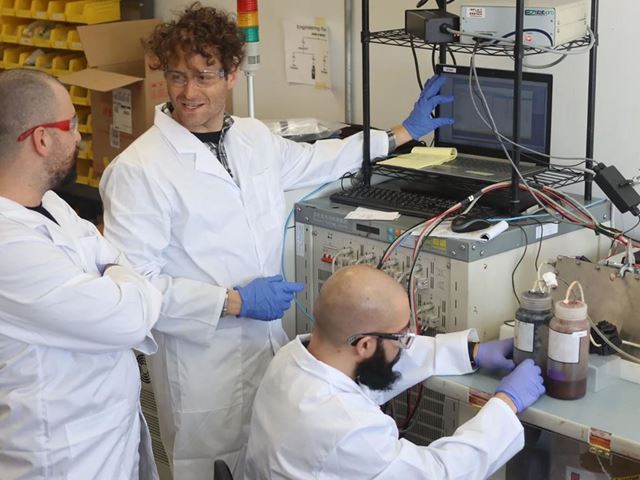
- Latest: Welcome to Auto Futures - Mobility News, Features, Exclusives and More...
- Latest: Mercedes-Benz Unveils the SUSTAINEER - an Electric Last-Mile Delivery Solution
- Latest: XPENG & Volkswagen to Jointly Develop Electrical/Electronic Architecture in China
- Latest: Honda Unveils Ye - its Next-Generation EV Series for China
- Latest: JLR Launches Portable Battery Energy Storage System Using 2nd-Life PHEV Batteries
- Latest: The US Startup Rolling out Urban Curbside EV Charging - Voltpost's CEO
"Nothing is Going to Stop us” - NASA-Backed Charging Pioneer Influit Energy - CEO John Katsoudas
Lynn Walford
- Sep 12 2022

Influit Energy’s liquid nanotechnology high energy density nanoelectricfuel (NEF) can be recharged like lithium-ion batteries or refuelled quickly like gasoline or liquid hydrogen. Plus, the fluids can be made with abundant materials that can be sustainably and cheaply sourced in the US.
John Katsoudas co-founder and CEO of Influit Energy explains the value and the great potential of its NEF system and its advantages over most current batteries and hydrogen.
Influit Energy is a spin-out of Illinois Tech that was started in 2009 with co-founders Katsoudas, Elena Timofeeva and Carlo Segre. The team is working on projects for DARPA, NASA and the US Air Force. Funding comes from grants and contracts from federal and defence agencies. In March at South by Southwest (SXSW) the company came out of stealth mode.
To help people understand what Influit is accomplishing, Katsoudas first talked about flow batteries that are already in existence but usually don't hold a lot of charge.
“The traditional flow battery commercially has been around since the 70s. But, the first flow battery is over 100 years old. You have a liquid that you can store a charge in and get the charge out. You flow it through a metal porous material that can conduct electricity,” says Katsoudas.
Examples of flow batteries often seen in science experiments are batteries made from lemons or potatoes that give out a charge from energy storage fluid.
There is a physical limit to how much ionic salt can dissolve into the liquid in flow batteries.
That physical limit makes flow batteries very low in energy density. Flow batteries can be very large for grid storage. But to move a car or an aeroplane, it would never work because the fluids have a fundamental limit on how much ionic salts that can be dissolved in that liquid, says Katsoudas.
“We have created a completely different type of liquid that can be used in the flow battery format. The different type of liquid is called a nanofluid,” he explains.
It is considered a two-phase system. The solid material is in a liquid material and they work together like composite material. Fluid is made with the properties of a solid and fluid—using nanoparticles. The new liquid can charge and discharge using the flow battery format.
Using nanoparticles, Influit gets a lot more material per unit volume. The Influit liquids that store energy are competitive with lithium-ion in the use of volumetric space, says Katsoudas.

What is Great about NEF?
A flow battery for transportation is a much more efficient design because the energy storage can be scaled independently from the engine. Or the engine can be made bigger and the tanks smaller.
“The design freedom makes the flow battery much more readily adaptable for transportation because you can get three-minute refuelling. If you needed to charge the battery and you don’t want to refuel, you could just plug it in. It would take just the same amount of time as it does with a lithium-ion battery,” says Katsoudas.
“We have taken the thing that makes solid batteries good and merged it with the things that make flow batteries good to create a perfect solution for transportation,” he adds.
The charging infrastructure works the same way for Influit NEF batteries. The pump stations will be different from traditional gas stations. Fast fuel refilling will require four nozzles, two to flow liquid in and two to pump the separate liquids out.
“When you're done using the fluid and the energy is discharged. Then you pump out the two discharge fluids, positive and negative fluid and pump in the fresh, positive and negative fluid that is charged.”
He reports that the Influit NEF system will last longer than competing batteries. Traditional flow batteries can last 10,000-20,000 cycles. Lithium-ion will go through about 2000 cycles.
“We anticipate Influit fluid batteries will be able to last longer, cycle longer and have a better cycle life than Lithium-ion batteries,” says Katsoudas.

What’s in the Secret Sauce of the Influit Fluids?
Influit fuel is made from sustainable materials.
“We didn't go after exotic chemistries. We went after the oldest most sustainable earth-abundant chemistries and effectively created nanofluids out of those,” says Katsoudas. Influit NEF fuel uses metal oxides.
“The Gen2 system that is the most efficient, uses iron. Iron is easy to obtain. It is everywhere and not a challenge to get and easily recycled.”
In comparison, lithium-ion batteries are difficult to recycle because the energy extraction is coupled to the energy storage in a sealed system, he says.
“With Influit NEF fuel, we just flow it through. We can completely separate the fluids from the device. If the fluids need to be reconstituted, it's not an issue. It is a simple chemical process,” he says.
According to Influit Energy’s FAQ -- NEF Gen1 system will be 23% greater energy density for the same system volume than Li-ion at half the cost. Gen2 will be a five-times increase at the system level over Li-ion and a third of the cost.
“Influit Gen2 chemistry is five times better with five times more energy density than a lithium-ion battery. That energy density is necessary to get regional aircraft in the air.”
What Kinds of Infrastructure Will Work with NEF?
“We are offering a new way to transport electrical energy that is independent of the grid, effectively turning every rail yard and eco-pipeline into additional electric transport in addition to what the grid can supply. That is why this is such a compelling and powerful technology. We are able to create a new type of addition to the transport of electrical energy that doesn't exist today. It gets around all of the bottlenecks for electric vehicle adoption," says Katsoudas.
There are going to be tankers that have large volumes of charged fluid just sitting there. They could just sit there refuelling and taking in the discharge fluid and storing that. Then when the grid has the capacity, those tanks could just be recharged, says Katsoudas.
The Influit NEF fluids could be pumped through existing pipelines, that are coated with a polymer. The materials can be held in the same plastic that is found in a milk jug, such as EPDM, polyethene ABS and other recyclable materials.
“We have a much better solution than both lithium-ion and hydrogen. It is a closed-loop energy cycle that allows you to have the best of both worlds - because the battery fluid is never consumed-- it's just recharged. From a consumer perspective, you will much more freedom to operate,” says Katsoudas.
Influit NEF is a universal fuel that can be applied to solve all the intractable problems with the electrification of transportation. The nanofluids are water-based and not flammable like hydrogen or batteries. The fluids have a viscosity of motor oil with a wholly unsupported nanosuspension, he says.
The nanofluid technology has been tested in warehouse vehicles, forklifts, floor scrubbers, warehousing and material handling vehicles.
“We already built our first fuel and put in an electric utility vehicle. We had our Kitty Hawk moment on June 22."
He predicts: "Something is coming around the corner that is better than everything. We have committed our lives to this. Nothing is going to stop us.”
Popular Categories
